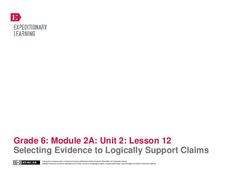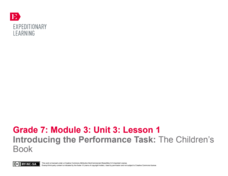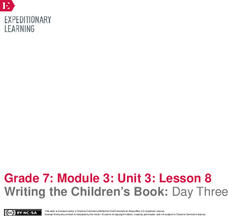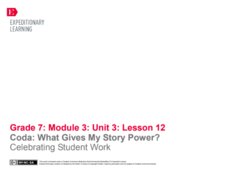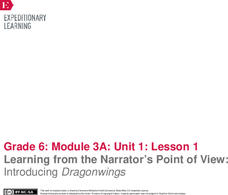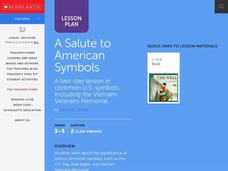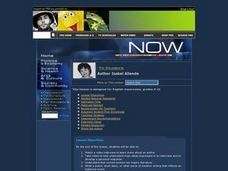EngageNY
Pitching Your Claim with Best Evidence
Does Bud use his rules to survive or thrive? That is the driving question of a lesson plan following the reading of Bud, Not Buddy by Christopher Paul Curtis. In an argument essay prewriting activity, pupils use textual evidence to...
EngageNY
Selecting Evidence to Logically Support Claims
It's time to make a rule sandwich! After exploring the writing assignment's rubric and analyzing a model essay, learners are guided through the prewriting phase using the sandwich technique. Pupils create their sandwich addressing the...
EngageNY
Reading Shakespeare: Understanding Shakespeare’s Language
Pupils participate in a drama circle to read Shakespeare's A Midsummer Night's Dream aloud. They work with partners to discuss Shakespeare's use of language and analyze how specific lines of dialogue within the play help propel the...
EngageNY
Analyzing Textual Evidence: Working Conditions in the Mills
Deafening, dusty, debris. Such were the working conditions in the 1800s textile industry as portrayed in Katherine Paterson's novel Lyddie. Scholars watch a short video clip about life and work in the mills. Next, they work...
EngageNY
Forming Evidence-Based Claims: Should Lyddie Sign the Petition?
Pupils reread selected passages from Katherine Paterson's novel Lyddie. After they finish, individuals gather textual evidence supporting whether Lyddie should sign a controversial petition and record their findings on graphic...
EngageNY
Introducing the Performance Task: The Children’s Book
Using a Venn diagram, class members generate similarities and differences between narratives and summaries. Next, pupils co-create an anchor chart to capture their thinking about how an author zooms in on a particular part of a story.
EngageNY
Discussing and Identifying Themes: What Makes a Good Children’s Book?
Working in small groups, scholars look closely at a children's book to evaluate narrative techniques. Next, they complete a Children's Book Scavenger Hunt worksheet to analyze the literary elements of their selected stories.
EngageNY
Writing the Children’s Book: Day Three
Illustrations are a key feature of children's books. Using the resource, pupils learn about adding illustrations to their children's books. Next, as they complete their storyboards and work on their second drafts, they consider their...
EngageNY
Coda: What Gives My Story Power? Celebrating Student Work
It's time for a celebration! Scholars go on a gallery walk around the classroom to view their peers' completed illustrated children's stories. Using sticky notes, pupils provide feedback about the powerful elements they find in their...
EngageNY
Learning from the Narrator’s Point of View: Introducing Dragonwings
Journey into the past with Laurence Yep's Dragonwings. Scholars complete anchor charts to analyze techniques the author uses to develop the narrator's point of view in his novel. As they read, pupils also complete word catchers to...
National Math + Science Initative
Vocabulary Study: A Christmas Carol by Charles Dickens
Like Scrooge, your language arts learners will not shut out the lessons you teach in a vocabulary activity based on Charles Dickens' A Christmas Carol. Included in the packet is a variety of vocabulary activities and two...
Curated OER
Critical Ways of Seeing The Adventures of Huckleberry Finn in Context
Students complete a unit of lessons examining the cultural context of the novel, 'The Adventures of Huckleberry Finn.' They write a critique of the novel, compare/contrast two published critiques, and explore various websites.
Curated OER
A Salute to American Symbols
Young scholars explore American symbols. In this reading and social studies lesson, students read literature regarding American symbols and describe the significance of the symbols as they research them in groups.
MENSA Education & Research Foundation
Magical Musical Tour: Using Lyrics to Teach Literary Elements
Language arts learners don't need a lecture about poetry; they listen to poetry every day on the radio! Apply skills from literary analysis to famous songs and beautiful lyrics with a lesson about literary devices. As...
Curated OER
ESL Integrated Literature Unit
Students read and analyze information related to the book Island of the Blue Dolphin. They select appropriate information for the purpose of investigating part of the book.
Curated OER
The Civil War in Art and Literature
Pupils examine art related to the Civil War. They participate in activities that allow them to write poetry and drawings. They create their own journal and collect their work in a binder.
Curated OER
Unit on Henry David Thoreau
High schoolers investigate the writings of Thoreau in order to better comprehend his impact on American Literature and unique writing style. Working to evaluate the different pieces of writing, they read the essays in order to create...
Curated OER
Literature: Isabel Allende
Students watch and respond to a Bill Moyers Now video on the Chilean author, Isabel Allende. They brainstorm a list of recent events that might inspire writers and choose one to write about in poetic, diary, or short story form.
Curated OER
American Literature - The American Dream: Past, Present, and Future
Young scholars are introduced to the ideas of the American Dream at the turn of the century. They present their ideas on the American Dream at the turn of the century through a person characterized in Edgar Lee Masters' Spoon River...
Curated OER
TOTAL LITERATURE SERIES
Fifth graders listen and react to the book Number the Stars, by Lois Lowry. They write in their journals every day approximately one page or more as a reflection on the reading.
Curated OER
Unit Plan for Mark Twain and American Humor
Students create brochures about the humor of Mark Twain. For this literature-analysis lesson plan, students read "The Celebrated Jumping Frog of Calaveras County" and other short stories by Twain. Students write analytical paragraphs and...
Curated OER
Identifying and Using Parallelism and Balance in Literature
Students examine the story for use of balanced sentences and parallelism-two literary devices-and then practice using those devices in writing of their own. They combine the simple sentences grammatically into one correct sentence. A. I...
Curated OER
Read All About it
Learners create and publish a newspaper that reflects and explains pioneer and medieval societies. They become newspaper writers for a specific time period. They adopt a holistic approach to exploring community life in medieval and...
Curated OER
Collaborative Tall Tale Lesson Plan
Using Keynote, pupils will collaborate with their peers to create a tall tale. Each person in the group will participate by creating slides, adding text, and recording their voice. Tip: Have each group present their tall tales to the...

